HERPESVIRIDAE
Enveloped,
linear, dsDNA
General Characteristics
- A large group that causes a variety of diseases in mammals.
- Tendency toward viral latency in ganglia of neuron cells with
recurrent infection.
- Often involves incorporation of viral nucleic acid into the
host genome (provirus) and carries
with it the potential for oncogenesis.
- Two of the viruses of this group (HHV4-EBV and HHV8-Kaposi) have a well-documented
association with cancers,
and others have suspected involvement.
- Virtually everyone becomes infected with a herpesvirus at some
time, usually without adverse
effect. There are eight known herpesviruses out of 100 known herpesviruses that infect humans.
Taxonomy and Distribution
- There are more than 100 known herpersviruses which are currently
classified into three subfamilies:
Alpha
Beta
Gamma - All but one of the known viruses affects vertebrates.
- One invertebrate virus, of oysters, has been characterized.
- Most known herpesviruses infect mammals, or birds, but reptilian,
amphibian, and
fish herpesviruses also exist.
- Herpesviruses are ancient viruses that have coevolved with their
hosts.
- There are 8 known human herpesviruses (HHV) 1 through 8.
Structure
- Among the largest viruses, 100-300 nm diameter.
- Enclosed within a loose fitting envelope that contains glycoprotein
spikes protuding outward.
- Like any other enveloped viruses, they are prone to deactivation
by organic solvents or detergents
and are relatively unstable outside the host's body.
- They are structurally complex, consisting of four distinct morphologic
units.
-
HSV type I is an enveloped virus about 150
nm in diameter, the center of the virus is
an electron- dense core consisting of dsDNA.
-
The icosahedral nucleocapsid houses a core of
dsDNA that winds around a proteinaceous spindle in some viruses.
-
The nucleocapsid is made of 162 capsomers, each
of which is composed of a number of distinctly different proteins.
-
The nucleocapsid is surrounded by an amorphous
layer that is called the tegument, a fibrous structure
unique to the herpesviruses.
-
The tegument is located between the capsid and envelope. It consists of viral enzymes, some of which are needed to take control of the cell's chemical processes and subvert them to virion production, some of which defend against the host cell's immediate responses, and others for which the function is not yet understood.
-
The tegument is made of at least 20 different
virus-encoded proteins. The tegument is an amorphous, occasionaly asymmetrical, feature which consists of viral enzymes.
-
Surrounded the tegument is the envelope whose
outer surface contains small spikes.
- A large number of separate proteins are present within the virion, but not all of them have been characterized
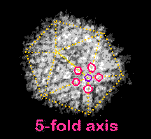 |
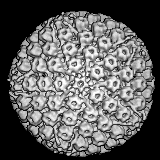 |
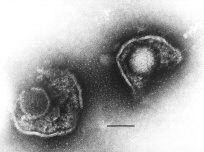 |
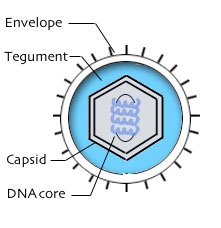 |
Genome
- Consists of one linear dsDNA molecule (about 30 times larger
than the SV40 genome). The DNA, wound in a
toroidal shape, makes up the core.
- The viral genome is large, 120-230 kb, and the viruses encode
many dozens of proteins, which allows
them to finally regulate their life cycle. Genome contains between 60 and 120 genes.
- The DNA sequence of this virus indicates that it codes for over
100 different proteins!
- Infection occurs by attachment of virus particles.
Infection
A herpesvirus infection begins with attachment to and penetration of a host cell (usually a post-mitotic cell).
Since herpesviruses are large DNA viruses, and they usually infect non-dividing cells, they encode enzymes involved in nucleic acid metabolism and DNA synthesis so they can copy their DNA once they enter the host cell.
By attachment of virus particles to specific cell receptors,
and, following fusion of the cytoplasmic
membrane with the virus envelope, the capsid is released into
the cell.
The capsids are transported to the nucleus, where viral DNA is uncoated.
Components of the virus particle inhibit macro-molecular synthesis by the host.
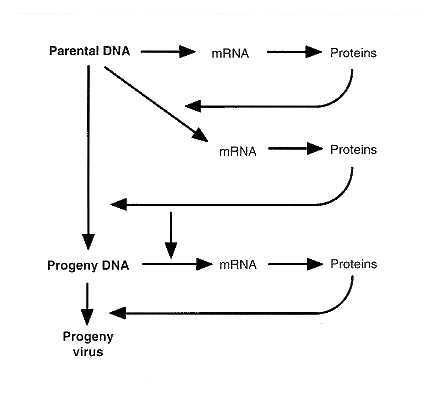
Source: Dr. Janet Butel, UTMB
Synthesis of Herpesviruses
There are three classes of mRNAs:
1. Immediate early which codes for five regulatory proteins.
During the immediate early stage, about 1/3 of the viral
genome is transcribed by a
host cell RNAP.
The immediate-early genes are for the most part regulatory, switching on the expression of the early genes, which are made before DNA replication.
The proteins made by the expression of the early genes include enzymes involved in DNA metabolism and replication.
2. Delayed early which codes for DNA replication proteins, thymidine kinase and DNAP.
Early mRNA codes for certain positive-acting regulatory proteins that appear to stimulate the synthesis of the delayed early proteins.
Delayed early, occurs only after the early proteins have been made.
During this stage, about 40% of the viral genome is transcribed.
Among the 10 proteins characterized from the delayed early stage are a DNAP and a DNA binding protein which are enzymes involved in DNA replication.
3. Late which codes for the proteins of the virus particle. The late genes are expressed after DNA replication, and are encoded to make structural proteins as well as elements of the tegument.
Replication
- Herpes viral DNA replication takes place in the nucleus.
- After infection, the genome apparently circularizes (remarkably
like bacteriophages) and replicates
by a rolling-circle mechanism.
- Rolling circle replication describes a process of nucleic acid
replication that can rapidly synthesize
multiple copies of circular molecules of DNA or RNA, such as plasmids, the genomes bacteriophages (lambda), and the circular RNA genome of viroids.
- A circular genome obviates the need for a special mechanism
to repair the ends of the DNA during replication.
- Herpesviruses encode more than 70 proteins.

Rolling circle replication*
*See the section of animations in this website for a detailed view of the process.
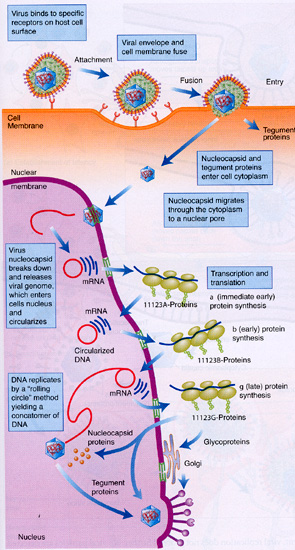 The Herpesvirus Life Cycle.
The Herpesvirus Life Cycle.
Upon entry the genome circularizes and the viral
tegument proteins and cellular factors are involved
in the transcription of the viral genome.
Transcription and translation occur in three phases:
(I) intermediate, (II) early, and (III) late.
Source: Teri
Shors. University of Wisconsin-Oshkosh. 2009. Understanding
Viruses. Jones & Barlett Publ. (p. 423)
- Long concatemers are formed that become processed to virus-length
DNA uring the assembly process itself (similar to bacteriophages).
- Viral capsids are assembled in the nucleus, and acquisition
of the virus envelope occurs via a budding process thru the
inner membrane of the nucleus.
- These long concatemers are processed to viral genome length
as they are incorporated into the capsid.
- The virus capsid capsomers are synthesized in the cytoplasm
and the capsid is assembled in the host nucleus.
- Mature virions pass through the ER of the host cell and exit
the cell from this site.
- In many cases the accumulation of viruses may cause disruption
of the cytoplasmic membrane.
- The amorphous fibrous coat that surrounds the capsid and the
envelope are acquired as the virus buds through the host nuclear
membrane.
- The assembly of this enveloped DNA virus differs markedly from that of the enveloped RNA viruses, which are assembled on the cytoplasmic membrane instead of the nuclear membrane.
Diseases
Cause inapparent or inocuous disease, serious illness can result, particularly in neonates or in immunocompromised people.
Some cancers are also associated with certain herpesviruses.
Herpesviruses are persistent in:
1. Humans
2. Animals
Signs:
Creeping rash
Fever blisters
Genital infections
Herpesviruses persist in the ganglia of neuron cells

Epidemiology and Latency
- Herpesviruses have a narrow host range.
- Worldwide distribution - present in all populations of people
on Earth, including the most
remote tribes examined.
- Any particular herpesvirus is adapted to use only a single vertebrate
in nature.
- All are capable of establishing a latent infection in their
natural host whereby they persist for
the life of the animal.
- In their natural host, latent infections are usually established
in sensory neurons and lytic infection
often occurs in epidermal cells.
- Latent infection is established on one specific set of cells
that are nonpermissive or
semipermissive for virus to grow and which differ from virus to virus.
- A different set of cells is lytically infected so as to produce
a progeny virus that is capable of
spreading to new hosts.
- Reactivation of latent virus and lytic infection of permissive
cells allows the virus to reemerge
unchanged.
- Reactivation in some herpesviruses occurs only sporadically,
sometimes only at very long intervals,
whereas for others reactivation occurs more or less continuously and infectious virus is usually
present.
Human Diseases
In humans, herpesviruses can infect people of all ages and lifestyles.
For several of the human herpesviruses, sexual contact is the most common form of transmission.
One strain of human herpesvirus, HHV-8 (also known as Kapsi's sarcoma) is prevalent in immuno-suppressed individuals, such as people who have had an organ transplant and are taking immuno-suppressing drugs, and those with HIV.
-
Herpes simplex
I, II (HSV)
- Herpesvirus (HHV6, 7 and 8) - newly described HHV6 possibly involved in multiple sclerosis HHV7 found in peripheral T-cells. Its role in disease is not clear yet. HHV8 is sexuallly transmitted and associated with Kaposi's sarcoma in AIDS patients.
- Varicella- zoster (VZV also known as HHV-3) - an alphaherpesvirus. Varicella and shingles
-
Cytomegalovirus
(CMV or HHV5) - a betaherpesvirus.
- Epstein-Barr virus (EBV or HHV4) - a gammaherpesvirus.
Central Africa and New Guinea. Burkitt's lymphoma was among the first human cancers to be linked to virus infection.
- Monkey B virus (Cercopithecine herpesvirus-1)
Causes a serious and fatal illness in humans that is also of concern of animal handlers.
 Herpesvirus Type II |
 Herpesvirus Type I |
 Whitlow |
 Herpesvirus Blisters |
 Zoster virus (shingles) |